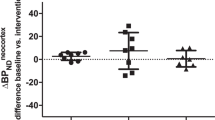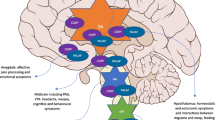Abstract
Purpose
Recent studies have proposed central serotonergic dysfunction as a major pathophysiology of migraine. We investigated serotonin transporter (SERT) availability in migraineurs using F-18-N-(3-fluoropropyl)-2β-carbomethoxy-3β-(4-iodophenyl) nortropane ([18F]FP-CIT) positron emission tomography (PET).
Methods
Brain [18F]FP-CIT PET images were obtained in eight women with migraine during headache free phase and 12 healthy adult women, 120 min after injection of 185 MBq. Non-displaceable binding potential (BP ND) of [18F]FP-CIT, which is an estimate of SERT availability, was calculated at the brainstem and compared with clinical parameters.
Results
BP ND at the brainstem was significantly higher in adult migraineurs (n = 6, 1.15 ± 0.17) than healthy subjects (0.95 ± 0.14) (p = 0.04). Healthy subjects demonstrated negative correlation between brainstem BP ND and age (r = −0.64, p = 0.02), whereas this age-related decline pattern was not found in the migraineurs. Severity of migraine attack was significantly correlated with brainstem BP ND (r = 0.66, p = 0.02), when age and duration of illness were corrected.
Conclusions
Increased SERT availability in the brainstem of adult migraineurs indicates low serotonin neurotransmission during headache-free phase. Patients who experience more painful headaches have lower serotonin neurotransmission. [18F]FP-CIT PET is a useful in vivo imaging technique for evaluating brainstem SERT availability in migraineurs.



Similar content being viewed by others
References
Lee KS. The diagnosis and most-updated therapy of migraine. J Korean Med Assoc. 2009;52:500–6.
Roh JK, Kim JS, Ahn YO. Epidemiologic and clinical characteristics of migraine and tension-type headache in Korea. Headache. 1998;38:356–65.
Ferrari MD. Migraine. Lancet. 1998;351:1043–51.
Tfelt-Hansen PC, Koehler PJ. History of the use of ergotamine and dihydroergotamine in migraine from 1906 and onward. Cephalalgia. 2008;28:877–86.
Chung JM. Preventive medications for migraine. Korean J Headache. 2010;11:42–9.
Ferrari MD, Saxena PR. On serotonin and migraine: a clinical and pharmacological review. Cephalalgia. 1993;13:151–65.
Hamel E. Serotonin and migraine: biology and clinical implications. Cephalalgia. 2007;27:1293–300.
Weiller C, May A, Limmroth V, Juptner M, Kaube H, Schayck RV, et al. Brain stem activation in spontaneous human migraine attacks. Nat Med. 1995;1:658–60.
Kim JS. Practical approach for the clinical use of dopamine transporter imaging. Nucl Med Mol Imaging. 2008;42:425–34.
Booij J, de Jong J, de Bruin K, Knol R, de Win MM, van Eck-Smit BL. Quantification of striatal dopamine transporters with 123I-FP-CIT SPECT is influenced by the selective serotonin reuptake inhibitor paroxetine: a double-blind, placebo-controlled, crossover study in healthy control subjects. J Nucl Med. 2007;48:359–66.
Lesch KP, Balling U, Gross J, Strauss K, Wolozin BL, Murphy DL, et al. Organization of the human serotonin transporter gene. J Neural Transm Gen Sect. 1994;95:157–62.
Headache Classification Subcommittee of the International Headache Society. The International Classification of Headache Disorders: 2nd edition. Cephalalgia. 2004;24:9–160.
Schuh-Hofer S, Richter M, Geworski L, Villringer A, Israel H, Wenzel R, et al. Increased serotonin transporter availability in the brainstem of migraineurs. J Neurol. 2007;254:789–96.
Sakai Y, Dobson C, Diksic M, Aube M, Hamel E. Sumatriptan normalizes the migraine attack-related increase in brain serotonin synthesis. Neurology. 2008;70:431–9.
Chugani DC, Niimura K, Chaturvedi S, Muzik O, Fakhouri M, Lee ML, et al. Increased brain serotonin synthesis in migraine. Neurology. 1999;53:1473–9.
Ferrari MD, Odink J, Tapparelli C, Van Kempen GM, Pennings EJ, Bruyn GW. Serotonin metabolism in migraine. Neurology. 1989;39:1239–42.
Pirker W, Asenbaum S, Hauk M, Kandlhofer S, Tauscher J, Willeit M, et al. Imaging serotonin and dopamine transporters with 123I-beta-CIT SPECT: binding kinetics and effects of normal aging. J Nucl Med. 2000;41:36–44.
van Dyck CH, Malison RT, Seibyl JP, Laruelle M, Klumpp H, Zoghbi SS, et al. Age-related decline in central serotonin transporter availability with [(123)I]beta-CIT SPECT. Neurobiol Aging. 2000;21:497–501.
Dahlstrom M, Ahonen A, Ebeling H, Torniainen P, Heikkila J, Moilanen I. Elevated hypothalamic/midbrain serotonin (monoamine) transporter availability in depressive drug-naive children and adolescents. Mol Psychiatry. 2000;5:514–22.
Maas HJ, Danhof M, Della Pasqua OE. Analysis of the relationship between age and treatment response in migraine. Cephalalgia. 2009;29:772–80.
Koch W, Unterrainer M, Xiong G, Bartenstein P, Diemling M, Varrone A, et al. Extrastriatal binding of [(1)(2)(3)I]FP-CIT in the thalamus and pons: gender and age dependencies assessed in a European multicentre database of healthy controls. Eur J Nucl Med Mol Imaging. 2014;41:1938–46.
Ruhe HG, Booij J, Reitsma JB, Schene AH. Serotonin transporter binding with [123I]beta-CIT SPECT in major depressive disorder versus controls: effect of season and gender. Eur J Nucl Med Mol Imaging. 2009;36:841–9.
Acknowledgments
We thank Mi-Sun Ahn and Sun Young Oh for assistance in data acquisition; Jae Sung Lee for providing FMItool; Mi-Ok Kim, Jae-Hoon Baek, Ji-Han Kim and the rest of the staff at the Korea University Anam Hospital PET center for excellent technical assistance. This work was supported by Korea University Grants [K0931131, K0932081].
Conflict of Interest
Eunkyung Park, Yu Mi Hwang, Min Kyung Chu, and Ki-Young Jung declare that they have no conflicts of interest.
Ethical statement
The current study was approved by an institutional review board and has been performed in accordance with the ethical standards laid down in the 1964 Declaration of Helsinki and its later amendments. All subjects in the study gave written informed consent.
Author information
Authors and Affiliations
Corresponding author
Rights and permissions
About this article
Cite this article
Park, E., Hwang, Y.M., Chu, M.K. et al. Increased Brainstem Serotonergic Transporter Availability in Adult Migraineurs: an [18F]FP-CIT PET Imaging Pilot Study. Nucl Med Mol Imaging 50, 70–75 (2016). https://doi.org/10.1007/s13139-015-0373-x
Received:
Revised:
Accepted:
Published:
Issue Date:
DOI: https://doi.org/10.1007/s13139-015-0373-x




